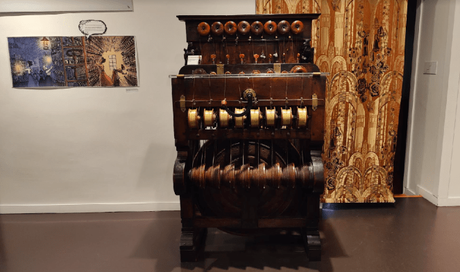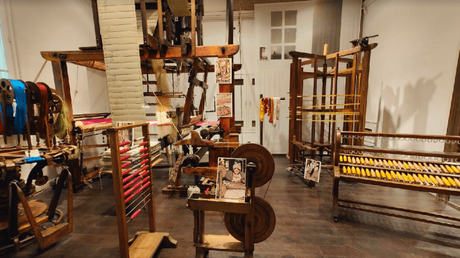It is often said that when you have no expectations, there is no disappointment and every moment is a pleasant surprise. This quote accurately mirrored my thoughts after I visited Lyon in France. A trip that I just booked on a whim to exhaust the final leg of my 15-day Euro rail pass, the city turned out to be quite a delightful revelation in immersive travel. Perched at the confluence of the Rhône and the Saône rivers in France, Lyon is a city replete with historical landmarks, architectural wonders and a bustling gastronomical scene. From ancient Roman ruins in Fourvière hill to unique museums in the old town and vibrant street art in its suburbs, Lyon I discovered had several aces up its sleeve. But the cherry on the cake was the city’s history of silk weaving centred around the La Croix-Rousse neighbourhood which spun a rather interesting tale.
Roots in the Renaissance Era
As I trudged along the uphill streets of La Croix-Rousse on a bitterly cold afternoon, the sight of spotting La Maison des Canuts’ was an instant relief. This museum dedicated to the heritage of silk weaving in Lyon is the perfect place to your exploration as it throws light on the history and evolution of the craft through its displays that are spread over three rooms. As I discovered here, silk weaving in Lyon started in the fifteenth century when King Louis XI set up a silk factory with workers mainly from the Italian region of Calabria in the year 1466. It was not until 1536 that the industry got a shot in the arm when King Francis I granted the city the privilege to weave for the nobles. Since then, the industry flourished and reached heights of prosperity contributing richly to the economy until the mid-17th century. During this period, there were close 14000 looms operated by Canuts which was the term used for master weavers in Lyon. Derived from the word ‘canette’ which is the bobbin inside the shuttle, canuts were experts in weaving using gold and silver threads and often worked for a merchant called soyeux in French. The merchants provided orders and the silk threads for the canuts who got the job done with the help of their apprentices.

Display in La Maison des Canuts
" data-orig-size="1258,746" sizes="(max-width: 663px) 100vw, 663px" aperture="aperture" />Display in La Maison des CanutsThe museum which was set up in 1970 by a cooperative of Lyon craftsmen houses a treasure trove of information on the silk industry and on display are looms, the various tools and accessories used by the canuts. The invention of the Jacquard loom and punch card technique by Joseph Marie Jacquard born to master weaver Joseph Marie Charles is also well displayed. The museum also throws light on the canuts’ lifestyle and the revolts of 1831, 1834 and 1848 when hundreds of weavers lost their lives while rebelling against the industrial revolution, a drop in the prices of silk and their decreasing wages.

Looms on display in La Maison des Canuts
" data-orig-size="1358,762" sizes="(max-width: 663px) 100vw, 663px" aperture="aperture" />Looms on display in La Maison des CanutsI was lucky to have reached the museum right in time for a live demonstration where our guide led us to the workshop and operated a 19th century Jacquard loom with a detailed explanation on the mechanism and the nuances of warps, wefts, bobbins, shuttles etc. Today the La Croix-Rousse neighbourhood is home to the last two remaining workshops where Jacquard hand looms are operated by about eight artisans who weave for historic monuments, castles, restoration projects and the like.
Traboules: Secret Pathways of the Past
A pivotal aspect of the silk industry in Lyon was its labyrinth of around 400 narrow passages, staircases and corridors collectively called traboules, most of which are found in the Croix-Rousse and Vieux-Lyon districts of the city. These covered pathways were literally the lifeline of the silk industry and were used extensively by the canuts to transport goods quickly across the city and overseas via the river. It also protected the goods from the vagaries of the weather and offered several strategic shortcuts which helped the canuts even during the days of the uprising.
Another round of arduous climbing through narrow, upwardly sloping lanes while negotiating multiple flight of stairs led me to one such passage where the characteristic Renaissance arches and spiralling staircase were unmissable.
It was almost dusk and while the place appeared cold and desolate physically, the concrete walls seemed to hold several stories of lives well lived, of growth, struggle and strife. A plaque commemorating the indomitable spirit and the contribution of canuts towards the development of Lyon was also installed here. Most traboules of Lyon today are privately owned and serve as residences.
Mur des Canuts: An Ode to the Life of the Silk Weavers
My last stop in the silk quarter was the Canuts wall which is a spectacular mural painted on the wall of the Canuts Boulevard (Boulevard des Canuts). Painted using the Trompe-l’œil style which is French for deceive the eye, this mural captures the lifestyle of the canuts. Spread over 1200 square foot, it is one of the largest murals and painted walls in Europe and a stunning piece of street art in France. Intricate details, a stunning three-dimensional effect and hyper realistic imagery makes this piece of art by the CitéCréation cooperative a compelling spectacle. Done in pastel hues, the mural depicts the typical houses of the canuts with high ceilings to accommodate looms and large windows, scenes of silk weaving, a silk shop and a central staircase that adds depth to the entire piece.
The mural was first painted in 1987 and since then has not only impeccably maintained but also revised periodically in 1997 and 2013 to reflect the changes in the Croix-Rousse neighbourhood. The changes have been in terms of updated architecture, inclusion of modern shops, ‘adding age’ to the characters of the mural and the inclusion of greenery reflecting Lyon’s commitment to sustainability.
As darkness envelopes the city, I cannot help but reflect how well this wall manages to keep the spirit of the silk weavers alive while also serving as a platform to showcase a piece of living history.
Lyon is located about 300 km from the city of Nice and is a two hour train journey from Paris.
Another version of this article was first published in the New Indian Express.
